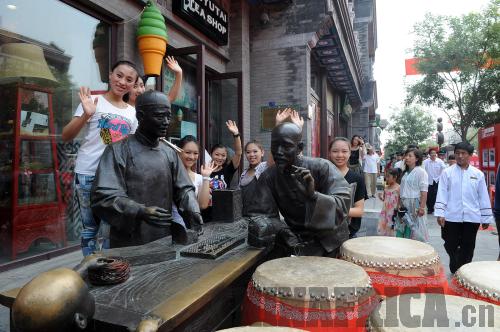| 
As a foreigner anywhere, it is important to make an effort to experience the cultural heritage of the city you are in. In Paris you should visit Montmartre, in London you can't miss Buckingham Palace, and before you leave Sydney, a trip to the Blue Mountains is essential. For Beijing, the unquestionable birthplace of Chinese culture is buried deep within the city's ancient hutongs.
Having once been at the nucleus of dynastic life and culture, the hutongs of Beijing have faced a turbulent journey to modernity. Their plight is well documented and it is a heartbreaking story to say the least. As the country hurtled toward development during the 1990s, the Beijing hutongs faced the threat of developers who wished to modernize the city. By 2003, preservationist groups had come to the rescue of the humble hutong, but by then, it was already too late and many had been knocked down to make way for skyscrapers and parking lots. Today, less than 1,000 original hutong areas remain intact.
For the few hutongs that managed to evade the wrecking ball, a new threat has emerged in the eyes of the locals. "We call it a 'new-tong,'" said Beijing local, Christina, rolling her eyes. "Sure, the buildings are the same, but they have lost everything that made them authentic."
She is referring to Nanluoguxiang, a refurbished hutong area just north of the Forbidden City. Originally built during the Yuan Dynasty (1271-1368), Nanluoguxiang is one of the oldest hutong areas in Beijing. However, since the opening of a subway station at the southern entrance in 2012, Nanluoguxiang has been transformed into a bustling hangout for tourists and locals alike.
Nanluoguxiang isn't alone in its commercialized fate. Ping'anli and Qianmen are just two examples of ancient hutong areas that have buckled under the pressure to commercialize. Instead of the wobbly rickshaws and pet birds in cages promised by guide books, the streets of these hutongs are instead filled with fast food chains and designer stores. Here the most "ancient" thing you are likely to find is a copy of the 1999 Backstreet Boys' album Millennium. And that's about as old as it gets.
It is easy to get wrapped up in the atrocity of it all. But to what extent should we defend authenticity?
I have always found it dangerous to bring too many preconceptions to the definition of a city. Too often we are seduced by an image of a place that barely resembles its true nature. We accept the stereotype, no matter how far removed it is from the truth, because the truth isn't as pretty.
The same is true of what the hutongs are to Beijing. It is far more pleasant to think of Beijing as a city of quiet, cobbled streets, than a city that is caught awkwardly between tradition and modernization.
While anyone can appreciate the importance of the hutongs as cultural relics, there is a reason for their transformation. During the turn of the century when the hutongs began to disappear in large numbers, so too were the ideas of the "commune" being dismantled and replaced by new attitudes to the individual. The new Beijing, though reverent of its past, is complex beyond the simple, collective life of the hutong and so the hutong itself has changed. These "new-tongs," with their conflicting and confusing clash of old and new, do a far better job at explaining the current Beijing than those that have been preserved in their original state.
Though the skeleton of history still remains, modern hutongs like Nanluoguxiang represent a fresher-faced Beijing - one that is curious, extraverted and interested in exploring life outside of its traditional communal boundaries. As long as the hutongs remain, the past will never be forgotten. But their changing nature should be embraced so that a new cultural identity may be forged.
So before you turn your nose up at the flashy, refurbished streets, take a moment to surface from the nostalgia and look around. You might find there is more to learn from a frozen yogurt vendor or designer label about the wonderfully contradictory mess of a city that is the new Beijing. |